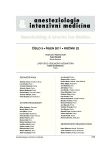Ultrasound guided medial cervical plexus blockade
Authors:
Nalos Daniel 1; Humhej Ivan 2
Authors place of work:
ARO Masarykova nemocnice v Ústí nad Labem, Krajská zdravotní, a. s.
1; Neurochirurgická klinika, UJEP, Masarykova nemocnice v Ústí nad Labem, Krajská zdravotní, a. s.
2
Published in the journal:
Anest. intenziv. Med., 22, 2011, č. 5, s. 249-252
Category:
Anesteziologie - Původní práce
Summary
Objective:
To assess the reliability and safety of ultrasound guided medial cervical plexus blockade.
Design:
Prospective observational study.
Setting:
Department of Anesthesiology and Critical Care, Regional Tertiary Hospital.
Materials and methods:
We studied 50 ASA II-III patients (28 males and 22 females, average age 62 years) undergoing carotid endarterectomy. Medial cervical plexus blockade was performed under ultrasound guidance using „in plane“ technique. We injected 20 mL of 0.375% bupivacaine in between the fasciae dividing the sternocleidomastoid and levator scapulae muscles. All patients received 100 mcg of intravenous fentanyl after block administration. We documented the incidence of satisfactory blockade for carotid artery surgery, the need for supplementary infiltrative local anaesthesia with 1% trimecaine, the need for conversion to general anaesthesia and the complication rate.
Results:
Medial cervical block without any supplementary local anaesthesia was achieved in 32 (64%) patients. Supplementary infiltration of local anaesthetic into the operative area was required in 17 (34%) patients. Only one patient required repeated local anaesthetic supplementation.
Conclusion:
Conversion to general anaesthesia was not necessary in any of our patients. The following complications were encountered: transient unilateral recurrent nerve block in two patients and transient phrenic nerve block in one case.
Keywords:
regional anaesthesia – ultrasound – cervical block
Zdroje
1. Pandit, J. J. et al. Superficial or deep cervical plexu block for carotid endarterectomy. Systemic review of complications. Br. J. Anesth., 2007, 99, p. 159–169.
2. Horáček, M. Povrchový cervikální blok pro operaci krčních tepen. Sborník XVI. kongresu ČSARIM, 2009. Regionální anestézie I., Předn. č. 3. Dostupné na www: www.csarim.cz.
3. Nalos, D. et al. Superficial and interfascial cervical block – MRI study. Anest. intenziv. Med., 2011, 22, 4, s. 215–218.
4. Zhang, M. et al. The investing layer of deep cervical fascia does not exit between the sternocleidomastoid and trapezius muscles. Otolaryngol. Head Neck Surg., 2002, 127, p. 452–454.
5. Pandit, J. J. et al. Spread of injectate with superficial cervical plexus block in humans: an anatomical study. Br. J. Anaesth., 2003, 91, p. 733–735.
6. Nalos, D. et al. Fascie brachiálního plexu. Anest. intenziv. Med., 2010, 21, 4, p. 185–190.
7. Winnie, A. P. et al. Interscalene Cervical Plexus Block A Single-Injection Technique. Anesth. Analg., 1975, 54, p. 370–375.
8. Dhonneur, G. et al. Demonstration of the Spread of Injectate With Deep Cervical Plexus Block: A Case Series. Reg. Anesth. Pain Med., 2007, 32, p. 116–119.
9. Casutt, M. et al. Intermediate cervical Plexus Block for Karotid Endarterectomy: Case Series of the Spread of Injectate. J. Anesth. Clinic Res., 2011, 2, p. 2.
10. Hakl, M. et al. Regional anaesthesia for carotid endarterectomy: an audit over 10 years. Br. J. Anaesth., 2007, 99, 3, p. 415–420.
Štítky
Anesteziologie a resuscitace Intenzivní medicínaČlánek vyšel v časopise
Anesteziologie a intenzivní medicína

2011 Číslo 5
- MUDr. Lenka Klimešová: Multioborová vizita může být klíčem k efektivnější perioperační léčbě chronické bolesti
- Realita léčby bolesti v paliativní péči v Německu
- Neodolpasse je bezpečný přípravek v krátkodobé léčbě bolesti
- Léčba akutní pooperační bolesti z pohledu ortopeda
- Perorální antivirotika jako vysoce efektivní nástroj prevence hospitalizací kvůli COVID-19 − otázky a odpovědi pro praxi
Nejčtenější v tomto čísle
- Ultrazvukem naváděný mediální cervikální blok
- Je rozdiel v prežívaní pacientov s kraniocerebrálnym poranením s meraným a nemeraným intrakraniálnym tlakom?
- Mechanismus vzniku hypotenze po i. v. paracetamolu u kriticky nemocných
- Doporučení pro poskytování poanestetické péče
